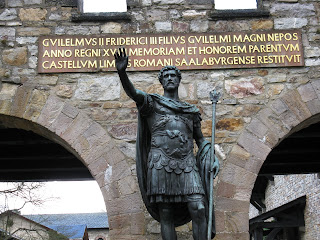 In German tradition, there is a celebration called Erntedankfest (Harvest Thanking Festival), which usually takes place in a church on the first Sunday in October. People will display their agricultural product in a beautiful way to thank God for his gifts of food and nutrition. The festival also associates with appreciation to the farmers and with free food giving to the poor. The fruit basket, representing this festival, was a gift put together by two of my German friends, Sibylle, my project partner, and Margrit, my landlord, when they came to the "UMD Thanksgiving Dinner" at my temporary home in Berlin.
In German tradition, there is a celebration called Erntedankfest (Harvest Thanking Festival), which usually takes place in a church on the first Sunday in October. People will display their agricultural product in a beautiful way to thank God for his gifts of food and nutrition. The festival also associates with appreciation to the farmers and with free food giving to the poor. The fruit basket, representing this festival, was a gift put together by two of my German friends, Sibylle, my project partner, and Margrit, my landlord, when they came to the "UMD Thanksgiving Dinner" at my temporary home in Berlin.


It was planned from the beginning that students are invited to my apartment for a Thanksgiving Dinner. (The event was even stated in the syllabus!) It is a traditional American family festival, so it was the least I can do, as their teacher and Resident Director, to provide a home away from home for this special day. As one can see in the two pictures, we had traditional American Thanksgiving food items, including turkey, sweet potato, corn, cranberry sauce, gravy (in the pot). Güller, a Turkish neighbor, prepared two Turkish dishes for us. Students also brought soft drink, sweet potato, broccoli and red cabbage dishes. So, there was plenty and varieties of food for people to taste.
After the dinner, we sat in a circle and talked, mostly in German, about what we have to be thankful for. Some thanked their family and their friends at home, but some also thanked the friends they spent this semester with. One particular student was thankful because her best friend recently had a very bad car accident back home, but survived.

Students also played a German geographic game toward the end of the evening. It was fun watching them play because while playing, they got to chat and tease and build a bond. In addition, the game helped them to know more names of Germany towns.
Overall, the get-together was not only a feast for students, it provided them with outlet to voice their opinion about various topics. They got an opportunity to practice their German with other guests. They seemed to have a good time playing the game. They took with them some leftovers so that they don't have to cook or buy lunch the next day.
Above all, they bravely combated with me on this important family holiday the feeling of being homesick.

































